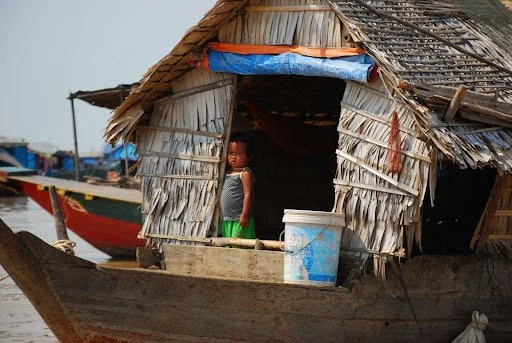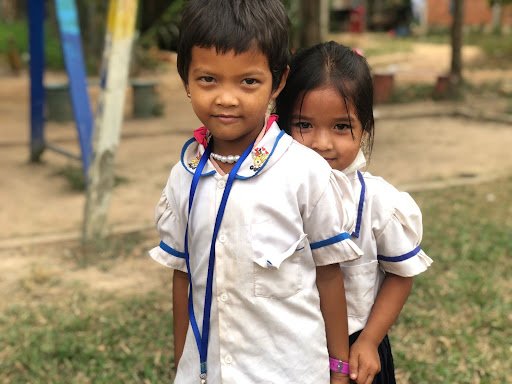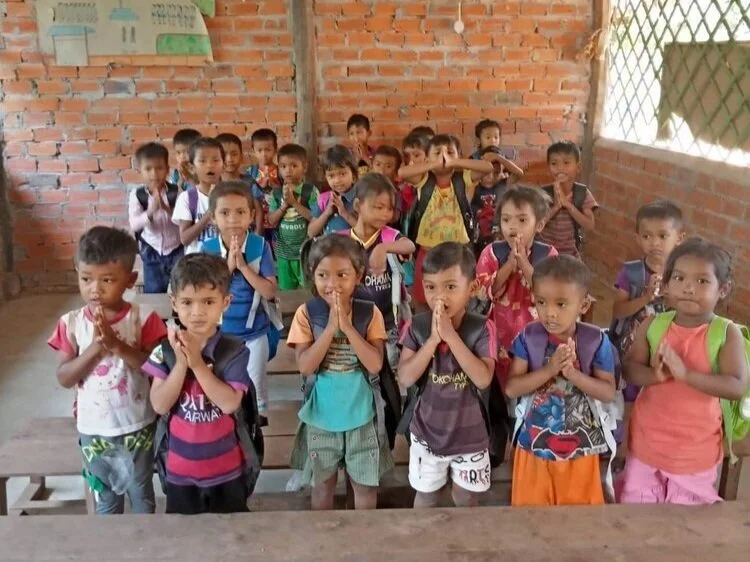Cambodia Children: Why They Need Your Help
In the decades following the genocide that killed between 1.5 to 2 million people, Cambodia continues to build beyond its bloody past. The nation has made progress since the fall of the Khmer Rouge regime but continues to face difficulties as they push forward into the 21st century.
The nation's struggles affect everyone, but they have the most severe impact on children - who make up a third of the population.
In this article, you’ll learn why Cambodian kids are at risk. The most important issues affecting children and their communities. And most importantly, how you can take action to fight for child rights in Cambodia and Southeast Asia.
Child Poverty
Poverty remains one of the most widespread and troubling issues that affects children in Cambodia. A recent UN study found 50% of Cambodian children live below the poverty line, compared with 28% of the total population.
Impoverished or marginalized children are at risk for a range of other ailments including poor sanitation, malnutrition, and bad health.
Poverty does not affect all children equally. A wide gap exists between kids living in rural areas of the country, and those living in urban areas with more development like Phnom Penh.
Cambodia’s rugged countryside makes it more difficult for rural children to receive the benefits of the modern economy. While cities like Phnom Penh have enjoyed increased economic development from technology and tourism, poverty rates can reach as high as 90% in rural Cambodia.
Infant Mortality
Infant mortality refers to the death of a child before their first birthday. These premature deaths are tough on mother, child, and the community. Most organizations measure this statistic, in deaths out of every 1,000 children.
National levels of infant mortality in Cambodia are 22 per 1,000 children. This is well above the international average, and rates in other nations in Southeast Asia.
In comparison, the infant mortality rate in the United States is 5 per 1,000, and 17 out of 1,000 in neighboring Vietnam.
Like poverty, this does not affect each family equally. Studies find that families in poor rural areas suffer higher rates of infant mortality.
Child Labour
While considered a form of modern slavery by some, child labour is practiced in much of Cambodia. A Humanianum.org study found that “labor is an everyday reality for around 45% of children aged 5 to 14 in Cambodia”. That's over 300,000 children forced to work at an early age.
The practice is particularly common in rural areas of the country. Children provide a cheap source of labour for families. In Siem Reap, the area our organization services, both young boys and girls are put to work on family farms or rice fields.
This type of child labour is understandable for a family in need, but it can have long term repercussions for the children involved.
Labour often comes at the expense of a child’s education. While it may provide a temporary fix for families, it can perpetuate a cycle of poverty which is hard to break.
Abuse & Trafficking
Child trafficking and abuse is a harrowing reality for youth in Cambodia. Every year thousands of children, particularly girls, find themselves the victims of violence, forced prostitution, and other forms of abuse.
Sex trafficking is a serious issue amongst girls who attempt to find a better life in Thailand - Cambodia's more prosperous neighbor. Unfortunately, many women get sucked into Thailand's trafficking and sex trade when crossing the border.
In 2008, the Cambodian government passed a child protection law aimed to prevent trafficking and sexual violence within and around Cambodia. While the bill has raised awareness for the issue, there continues to be a high rate of trafficking in Cambodian society and at its borders.
Orphan Abuse
Orphans represent one of the most vulnerable groups of children in Cambodia. Weak child rights and child protection laws make orphans easy prey for exploiters.
The rise of volunteer tourism puts orphans at even greater risk. In this trend, thieves and exploiters use orphanages as a front to embezzle money from concerned volunteers or sponsors from the West.
Of these abusive orphanages, PBS report: “There were about 150 in 2005. Today, there are more than 400, housing more than 16,000 children. Often, they are put on display, dancing for tourists who are then coaxed to leave a donation.”
As a whole, Cambodia lacks access to early childhood care. This can cause poor families to give a child to an orphanage with the hope they'll receive basic care, food and shelter.
Even a well intentioned orphanage may struggle to keep up with the supply of children coming in. The vast majority don't have the resources to ensure children have support they need.
Right To Education
In recent years, Cambodia has increased access to education. More parents send their kids to school, resulting in a youth which is better educated than past generations. However, there is still work to be done.
Many communities in Cambodia lack basic education and early childhood care. Children that attend school often fall below the learning standards for their age. A UNICEF report finds:
"Only 27 percent of 3- to 5-year-olds are developmentally on track in literacy and numeracy, and by the time they are 17 years old, 55 percent of adolescents will have dropped out of school."
Additionally, the government does not provide proper funding for primary schools. A family can expect a meager $1.75 a year for their children's education. When the government does supply funds, there is a lack of oversight or accountability - making it hard to buy supplies for students and hire quality teachers.
As in many parts of the world, education and economic development are intertwined. In poor, rural areas of Cambodia fewer children attend primary school. As a result, they earn less than their urban counterparts later in life.
Because of the interconnectedness, investing in early education remains one of the best ways to improve the lives of marginalized children and their families.
Reasons To Be Optimistic
While some of these statistics are alarming, recent developments leave room for optimism. In recent years both the Cambodian government and private organizations have made progress addressing poverty, health, and improving children's rights.
Since the turn of the 21st century, GDP grew at an average annual rate of over 8% between 2000 and 2010 and about 7% since 2011.
Growth in tourism and the garment industry, especially in the cities, has helped many in Cambodia's population escape poverty.
The number of children enrolled in primary education has increased from 82 per cent in 1997 to over 97 per cent in 2017/18.
These numbers give hope that with continued support, each child in Cambodia may improve their life and future.
How Can I Help Cambodian Children?
There are many options for those concerned with the will-being of Cambodian children. These options include everything from private funds and charities to volunteer services.
Here are some extraordinary ways people like you can help the children of Cambodia.
Volunteer Opportunities
When the government has failed, generous volunteers have answered the call to help Cambodia and its children.
Volunteer programs range in their mission and scope. Some have people teach and tutor children in English. Others put volunteers to work on local construction projects, or in hospitals and orphanages.
Our organization, The Hearts Company, supports schools and students in the area. In the past our volunteers have helped raise money, shared information, and delivered supplies like books and backpacks to the children at our schools.
Child Sponsorship
Child sponsorship is another popular way to support children in Cambodia and other vulnerable parts of the world like Africa and the Middle East. Sponsorships come in all shapes and sizes, but in each program a sponsor will pay basic expenses for a particular child in need.
Companies like Save The Children offer individual sponsorships where donors' money goes to a specific child or orphan. Other organizations use sponsorship money to fund larger projects aimed at the health of children and their community.
For example, our sponsorship program pays for the tuition, supplies, and salary of teachers and schools in Cambodia.
Charities & Non-profits
An increasing number of charities and nonprofits service Cambodian children. These include popular global organizations like:
Many reputable organizations work specifically in the region such as:
Smaller nonprofits may focus on specific child-related causes. For instance our organization provides access to quality education for children in Cambodia.
Support Cambodian Children With The Hearts Company
If you'd like to support the lives and rights of the children in Cambodia, please consider a donation with The Hearts Company. Through support from generous donors, we've raised the money to pay for schools and supplies for many children in Cambodia’s Siem Reap region.
In total, we sponsor four schools and over 800 children. Donations have allowed us to keep school open during the COVID crisis which greatly affected children in the area.
This year we need your support to pay for supplies, utilities, and teachers at our schools. Every dollar donated goes towards a brighter life for our children, their parents, and community.
Take a stand for children in Cambodian and vulnerable parts of the world. Donate today!




